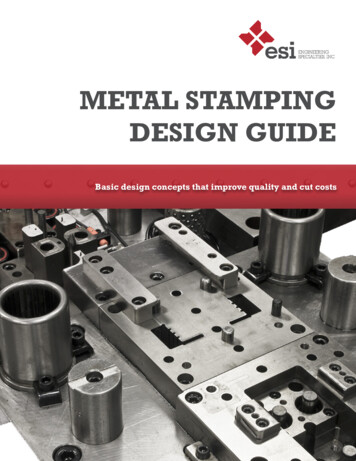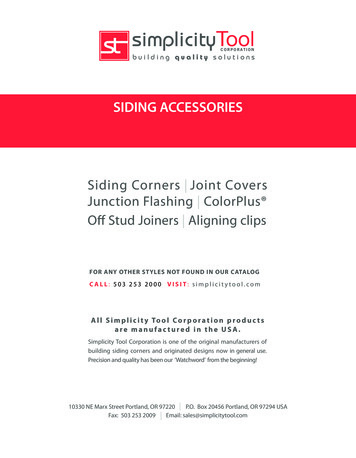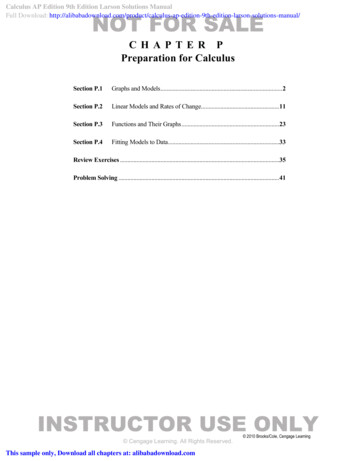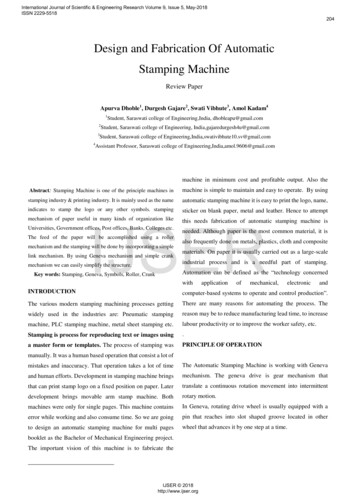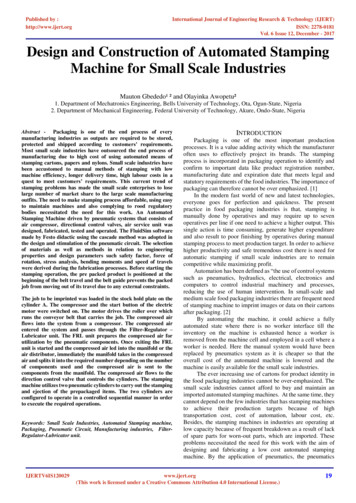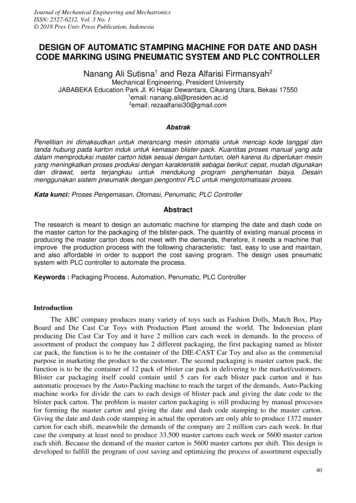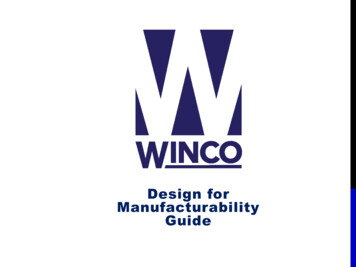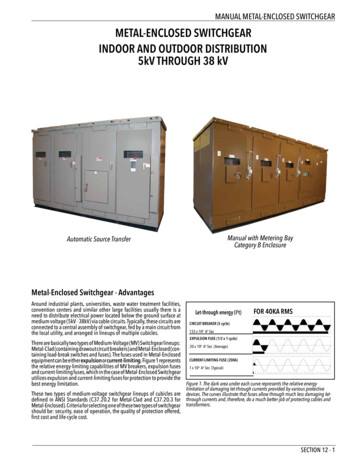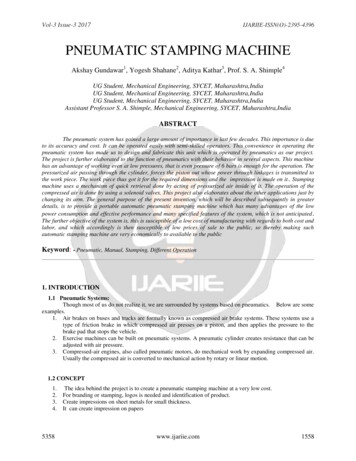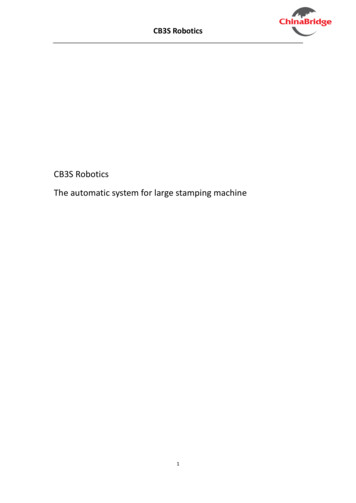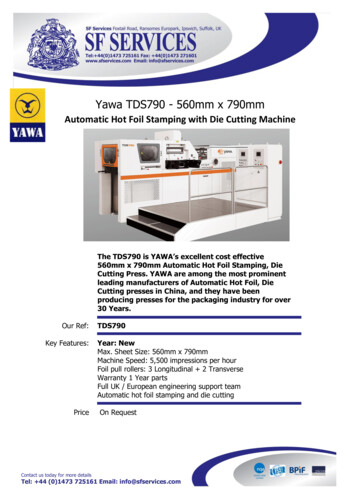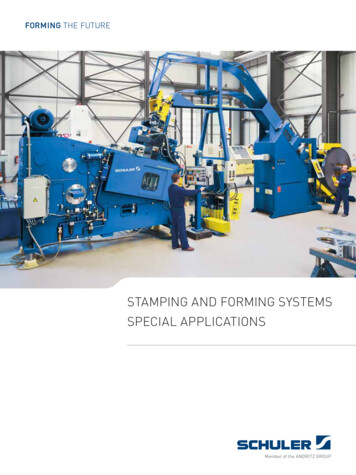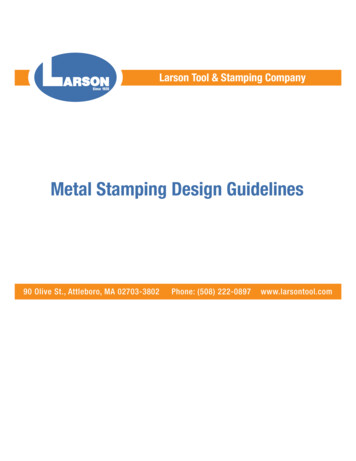
Transcription
Larson Tool & Stamping CompanyMetal Stamping Design Guidelines90 Olive St., Attleboro, MA 02703-3802Phone: (508) 222-0897www.larsontool.com
Design Guideby Neil FongerMetal Stamping Design GuidelinesMetal Stamping is an economical way of producing quantities of parts that can havemany qualities including strength, durability; wear resistance, good conductiveproperties and stability. We would like to share some ideas that could help you designa part that optimizes all the features that the metal stamping process offers.Material SelectionThere are many sheet and strip materials to choose from that respond well to metalstamping and forming. However, price and availability can vary greatly and affect thecost and delivery of production metal stampings. There are factors that should beconsidered when selecting an alloy and specifying physical characteristics of thatmaterial.TolerancingMost common steel grades are offered in standard gage thicknessesand tolerances. These sizes are usually readily available as stockitems and are generally the best choice when cost and delivery are amajor factor. Rolling mills work from master coils, and so usuallyhave minimum order quantities, somewhere in the truckload range. Ifthe material required to produce a metal stamping order is much lessthan this quantity, a steel warehouse can search its inventory to findmaterial that might happen to fall within the specified tolerance, butthis makes availability a variable from order to order.Custom material can be purchased from companies that specialize in re-rolling smallerquantities, but the cost can increase exponentially.ChemistryOver-specifying an alloy is one of the biggest factors in driving up the cost of a metalstamping. There are many different alloys produced, in ferrous and non-ferrousmaterials alike, but even more so than thickness tolerances, the less common alloyswill be custom-produced by the mill and will be available in large quantities only. It ispossible to find someone who is supplying the same product for another customer.Like with non-standard thicknesses, this would be hit or miss, and dependent on thelarger customers’ requirements and delivery schedules.Larson Tool & Stamping Company (508) 222-0897 www.larsontool.com
The quality of steel products has increased greatly in the last 20 years or so.Continuous casting yields a very consistent and homogenous alloy mix. From ourexperience, today’s metals are more ductile and of a much more consistent quality.Savings can be had from taking advantage of the quality found in stock warehousedalloys.Blanking, Trimming, and PerforatingThe Anatomy of a HoleNormal metal stamping processes involve driving a sharpened tool steel punchthrough the sheet or strip material and into a die cavity where the slug or scrap isejected. Cutting clearances between the punch and die are closely defined andspecified. And the process produces a very predictable edge condition on the finishedpart. Basically, the punch starts out by trying to compress the material, producing arolled or radiused top edge. As the sharp punch begins to cut through, it shears thematerial, producing a straight, burnished wall, usually between 1/4 to 1/3 through. Asforces build up beyond the strength of the material it yields, breaking away in a linebetween the punch and die edges, and leaving a burr around the bottom edge.BurrsBurrs, like parting lines in plastics or flash on castings, are normal by-products of themetal stamping process. Blanking burrs are usually somewhat ragged, uneven andsharp. They can vary in height as punch and die edges become dull, but generally, upto 10% of material thickness can be expected. Burrs can be dulled or removed by massfinishing processes or secondary operations, depending on the application.Hole Dimensioning and TolerancingSince punch and die clearances are normally around 8% to 10% of material thicknessper side, the bottom portion of the hole or trim will be tapered the amount of dieclearance. Therefore, inside dimensions are normally measured at the shear, orsmallest portion, disregarding the breakaway. Likewise, an outside dimension will bemeasured at the shear or largest portion, with the breakaway tapering smaller. If thisbreakaway cannot be tolerated in a particular application, a hole or outside edgefeature can be re-trimmed or “shaved” to produce a straight edge. This must bespecified, and will require an additional step or secondary operation. Normal piercingand blanking operations are extremely repeatable and very close tolerances can beexpected. Size tolerances of .002” can be held in most applications.2
LocationIn most cases, holes pierced in a flat blank part can be done in the same operation,and location from hole to hole is repeatable within a close tolerance, usually /-.002”.The only exception is when holes are closely spaced ( 1-1/2 X material thickness) andmust be pierced in separate stations or operations. Gauging or feed accuracy willrequire more liberal tolerances. In the case of holes pierced on different planes, as in apart with an offset form, the added variables of bend tolerances and material springback must be considered and allowed for.Tooling ConsiderationsThe same compressive forces exerted on the material are shared by the tooling. A 1/2”diameter punch perforating .062 thick mild steel will require 2-1/2 tons of pressurebehind it to push through. At 80 parts per minute this places extreme impact forces onthe body of that punch. Punch tooling can fail catastrophically if there is not enoughcross-section area to support this force. To alleviate this condition it is best to designperforations with a cross-section or diameter equal to material thickness at aminimum.Bending and FormingMost metal forming is a linear process. That is, the work of perforating, forming andblanking is done by the up and down movement of press equipment. Amazinglycomplex shapes can be generated using this process, but a good metal stampingdesign will take the process and material into consideration.As a general rule, the lower the alloy and temper, the more formable the material.Tempers are rated in terms of how tightly they will bend without cracking and whetherwith the grain or across. In addition, the harder a material is, the more it will “springback” when formed and, from a metal formers standpoint, how much extra work orover- bend must be induced to achieve the specified angle. Generally, anything up to90 degrees can be done in one operation. Beyond that, a little more creativity may beneeded. Forming in this manner relies on a “leg” of material to be pushed or wiped upinto position while the base material is held flat. For that reason, the length of aformed leg should be at least 2-1/2 times the material thickness beyond a bendradius.3
DistortionAs metal is formed, it is displaced through the bend radius. Thematerial on the inside of the bend is compressed, while the materialon the outside of the bend is stretched.On thicker materials and bends with relatively small inside bendradii (2 X material or less), there could be some overall thinning ofmaterial through the bend. In addition, because material iscompressed on the inside of the bend, the excess gets forced outeither end of the bend radius, creating what is called bend bulges. Ifthey are not acceptable, the blank must be contoured to compensate. A note such as“Bulging not allowed in this area” should be added to the part drawing.For the same reason, when two adjacent sides are folded up, as in forming a box,some relief is needed at the base of the bend to avoid “pinched” corners. Usually, thiswould be in the form of a round hole placed at the convergence point of the sides.When a leg is formed up alongside a flat section of the part, consideration should betaken to the transition from form to flat. The flat section should be trimmed back tothe base of the bend radius. If the edge of a flat section must be flush with a formedleg, bend reliefs should be cut into the blank on either side of the leg.Dimensioning FormsFormed features are subject to a number of variables, including material thickness andtemper tolerances, angular tolerances on bends, and station-to-station inaccuracies inthe process. Dimensions should always be given to the inside of the formed feature.Angular tolerances of /- 1 degree or so should be allowed on bends of any angle. Forthis reason, tolerancing of features placed at the outer end of a form should take theangular tolerance of the bend and the distance from the bend into consideration.Where a feature has multiple bends, tolerance stack-up should be analyzed andallowed for. Where tolerances need to be tightly held, an additional qualifyingoperation may be required to meet this specification.Deep DrawThe ProcessDeep draw refers to the process of pulling a flat “blank” of material over a radiused dieedge and into a cavity, producing a closed bottom, round or irregularly shaped cup orcylinder. It should not be confused with stretch-forming. The blank is actually forcedinto a plastic state as it is dragged over the die radius and down into the die. Thisprocess is done under calculated and very controlled conditions involving blankholding pressures, punch and die radii, punch speed and lubrication.4
Anatomy of a Deep DrawThe 2 stages of a draw are cupping and drawing. When the punch first contacts theblank, the nose of the punch initially embosses the material into the die. Somestretching occurs at this point and produces what is known as a “shock line”. This is apronounced area of thinning around the radius at the bottom and just up into thestraight wall of the shell. Depending on the shape of the bottom, the material may stillbe near original thickness across the bottom face (flat bottom) or thinned out by astretching action (spherical bottom). As the blank is pulled into the die, the material atthe circumference gathers and the wall progressively thickens. As the blank is pulled into near shell diameter, the material thickens to as much as 10% over the originalthickness. Clearance must be provided for this thickening to occur so that the materialwill not get bound up between punch and die. In addition, the punch must be taperedso that the finished shell can be stripped off. Therefore, a drawn shell will taper frombottom to top. It is possible to minimize this through subsequent sizing operations,but not eliminate it entirely.The blank used to produce a shell is cut from rolled strip material with a grainstructure elongated across the blank in the direction of rolling. Since this cross-graindoes not pull into a drawn shape evenly from all directions, great stresses are inducedin the shell wall. Due to these uneven stresses, a drawn shell will not be perfectlyround. A flange added to the top of the shell will minimize this, but the smaller theflange, the less strength it has to keep the shell round.Specifying a Drawn ShellSince the original blank is so altered by the deep draw process, the wall thicknesscannot be specified in terms of mill tolerances. Depending on application, the threeways of specifying the thickness of material in a shell would be to call out thethickness of material to be used, the minimum wall thickness or the maximum wallthickness. Wall thickness can be specified in more detail, but only after developmentwork has been done with the draw process. Since the material is formed around thepunch, shells are typically dimensioned to the inside diameter, with taper allowed frombottom to top. Alternatively, the shell can be dimensioned to the outside diameter withthe maximum size found at the top, and tapering down to the bottom.If a straight shell with no flange is required, the shell will be “pinch-trimmed” – that istrimmed flush with the outside diameter. Since the shell has a radius at the top, theremaining trimmed edge will have a partial radius from the inside, abruptly ending in asomewhat sharp outer edge. Also, since the die must have enough clearance to acceptthe shell, there will be a slight flare at the top of the shell. The bottom of a shell can bepierced out in a similar manner to produce a tubular part, but the same pinch-trimprinciples apply to the inside diameter. If a straight, cut-off edge is desired, it wouldrequire a secondary machining or cut-off operation and should be specified on thepart drawing.5
FlatnessRaw Material: Coiled strip material by nature is not flat. As material is unwound off thecoil it retains some of that curve shape along its length, called coil set. In addition, thewidth of the strip usually has a slight arc to it. This is called crossbow. Coil set can beminimized or removed by material handling equipment at the beginning of the metalstamping process. But crossbow is much tougher to remove and generally survives toaffect the flatness of the finished stamping.Stamping ProcessAs described earlier, the metal stamping process places compressive forces on the rawmaterial. As the top edge is rolled into the cut, the bottom edge tends to turn slightlyalso. This distortion at the edges affects the flatness of the finished part, beingminimal in thinner or milder materials, but becoming severe in heavier stock ortougher materials such as stainless steels and high-strength alloys. When flatness iscritical, tooling can be designed to minimize distortion but may require extra stationsor secondary operations.For the same reason, perforated or trimmed features that are placed too close to eachother or the material edge tend to roll the material between, producing a distorted orthinned edge. The rule of thumb in stamping design is to leave a minimum of 1-1/2times material thickness between trimmed or perforated features. Also, the stretchingand compression of forming can distort holes adjacent to a form or bend. Holes arebest kept at least 2 times material thickness beyond the radius of a formed feature. Ifthis is not possible, the hole should be
Metal Stamping Design Guidelines Metal Stamping is an economical way of producing quantities of parts that can have many qualities including strength, durability; wear resistance, good conductive properties and stability. We would like to share some ideas that could help you design a part that optimizes all the features that the metal stamping process offers. Material Selection There are many .
